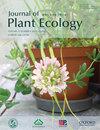丛枝菌根真菌对非生物综合胁迫下玉米(玉米)碳同化和生态平衡的影响
IF 3
2区 环境科学与生态学
Q2 ECOLOGY
引用次数: 0
摘要
丛枝菌根真菌(AMF)能增强植物对盐度等非生物胁迫的耐受性,提高作物产量。然而,它们的作用是多变的,而造成这种变化的根本原因在很大程度上仍是未知的。本研究旨在评估干旱如何改变 AMF 对植物抵抗高钙盐胁迫的影响。通过盆栽实验研究了在高钙胁迫和对比水条件下,接种 AMF 如何影响玉米的生长、光合作用、养分吸收以及 C:N:P 的化学计量比。结果表明,高钙胁迫显著降低了植物组织中菌根的定殖率、生物量积累、碳同化率和碳氮比。此外,在干旱条件下,钙胁迫对光合作用的不利影响加剧。在干旱和盐碱胁迫下,接种 AMF 能显著缓解光合作用的降低。然而,当玉米在水分充足的条件下受到钙胁迫时,接种 AMF 对玉米的表现几乎没有影响。此外,浇水改变了 AMF 对植物组织养分分配的影响。在水分充足的条件下,AMF能刺激根系和植株生长中的钾积累,但不能诱导叶片中与钙和氮成正比的钾积累,导致高钙胁迫下叶片中的钙:磷和氮:磷比率增加。相反,在干旱条件下,AMF 会降低叶片中的氮含量和氮磷比。总之,接种AMF可通过增强光合作用和调节养分配比(尤其是在缺水条件下)提高玉米对钙盐的抗性。该研究强调了复合胁迫下AMF在碳同化和养分平衡中的调控作用,为盐碱干旱地区提高作物产量提供了重要指导。本文章由计算机程序翻译,如有差异,请以英文原文为准。
Effects of arbuscular mycorrhizal fungi on carbon assimilation and ecological stoichiometry of maize (Zea mays) under combined abiotic stresses
Arbuscular mycorrhizal fungi (AMF) enhance plant tolerance to abiotic stresses like salinity and improve crop yield. However, their effects are variable, and the underlying cause of such variation remains largely unknown. This study aimed to assess how drought modified the AMF effect on plant resistance to high calcium-saline stress. A pot experiment was performed to examine how AMF inoculation affects the growth, photosynthetic activity, nutrient uptake, and C:N:P stoichiometric ratio of maize under high calcium stress and contrasting water conditions. The results showed that high calcium stress significantly reduced mycorrhizal colonization, biomass accumulation, C assimilation rate, and C:N stoichiometric ratio in plant tissues. Besides, the adverse effects of calcium stress on photosynthesis were exacerbated under drought. AMF inoculation profoundly alleviated such reductions under drought and saline stress. However, it barely impacted maize performance when subjected to calcium stress with well-watered conditions. Moreover, watering changed AMF impact on nutrient allocation in plant tissues. Under well-watered conditions, AMF stimulated P accumulation in roots and plant growth, but did not induce leaf P accumulation proportional to C and N, resulting in increased leaf C:P and N:P ratios under high calcium stress. In contrast, AMF decreased N content and the N:P ratio in leaves under drought. Overall, AMF inoculation improved maize resistance to calcium salt through enhanced photosynthesis and modulation of nutrient stoichiometry, particularly under water deficit. This study highlighted the regulatory role of AMF in carbon assimilation and nutrient homeostasis under compound stresses, which provides significant guidance on crop yield improvement in saline and arid regions.
求助全文
通过发布文献求助,成功后即可免费获取论文全文。
去求助
来源期刊

Journal of Plant Ecology
生物-植物科学
CiteScore
4.60
自引率
18.50%
发文量
134
审稿时长
3 months
期刊介绍:
Journal of Plant Ecology (JPE) serves as an important medium for ecologists to present research findings and discuss challenging issues in the broad field of plants and their interactions with biotic and abiotic environment. The JPE will cover all aspects of plant ecology, including plant ecophysiology, population ecology, community ecology, ecosystem ecology and landscape ecology as well as conservation ecology, evolutionary ecology, and theoretical ecology.
 求助内容:
求助内容: 应助结果提醒方式:
应助结果提醒方式:


